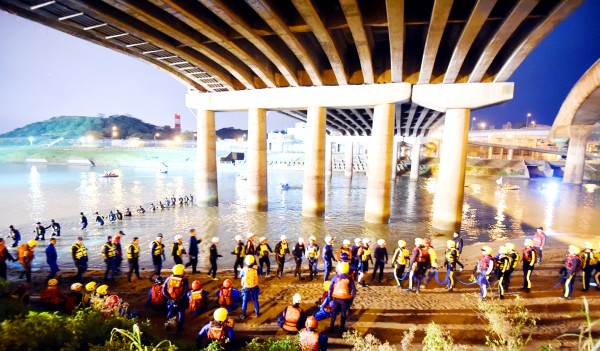《TAIPEI TIMES 焦點》 Pilot error may be to blame: investigators

A rescue team searches beneath the Nanhu Bridge in Taipei’s Nangang District yesterday for the remaining bodies of passengers from TransAsia Airways Flight GE235, which crashed in the Keelung River on Wednesday. Photo: Wang Min-wei, Taipei Times
QUESTIONS: Experts said human error could be behind Flight GE235’s pilots shutting down the plane’s working engine, but that the wreckage still needs to be inspected
Pilots on TransAsia Airways (復興航空) Flight GE235 might have shut down the wrong engine before trying in vain to restart it before the plane crashed in Taipei less than three minutes after departure on Wednesday, investigators and experts said.
Several aviation sites, including Flightradar24, speculated that the pilots might have mistakenly shut down the wrong engine in an attempt to restart the idled one, with analysts saying that the initial findings from the plane’s flight data recorder and cockpit voice recorder show that the accident might be attributed to human error.
David Learmount, the operations and safety editor at Flightglobal, an online publication that covers the aviation industry, was quoted in a New York Times report saying: “[The pilots] had a misconception about which engine failed, and they shut down the good one.”
Former US Airways pilot John Cox, who is now head of a safety-consulting company, was quoted in an Associated Press (AP) report as saying: “It’s a mistake,” and “there are procedures that pilots go through, safeguards, when you’re going to shut down an engine, particularly close to the ground. Why that didn’t occur here, I don’t know.”
When an engine quits, one technique that pilots often use is to identify and tell each other which engine is still running, then for one of them to place a hand behind the throttle controlling that good engine — guarding against an accidental shutdown, Cox said in the report.
It is likely that the crew’s failure to control the plane and shutting down the operating engine “will be part of the causal factors to this accident,” he said in the report.
However, Embry-Riddle Aeronautical University safety-science professor Anthony Brickhouse was quoted in the same AP report as saying that investigators would not really know what happened to the engines until they do a “tear-down” and actually examine them — instead of relying entirely on information from the flight data recorder — to determine whether one or both were still in working order.
The Aviation Safety Council also said that the findings from the plane’s flight data recorder and cockpit voice recorder released on Friday were just preliminary and the council had not assigned blame.
Three investigators from the French Bureau of Inquiry and Analysis for Civil Aviation and four from Pratt & Whiney — the Canadian manufacturer that produced the engines of the crashed ATR 72-600 — arrived at Songshan Air Force Base in Taipei yesterday, where parts of the plane that have been recovered are being stored.
The investigators could inspect and take photographs of the wreckage and, in certain circumstances, dismantle the plane to understand what happened to the engines, the council said.
Council executive director Thomas Wang (王興中) on Friday said that although the No. 2 engine triggered a flame-out alarm about 37 seconds after take-off, “the engine did not actually flame out and was still running” in feathered mode, which was automatically activated when the engine’s power became insufficient to produce enough thrust.
Wang said that although there was no sign of abnormality with the No. 1 engine, the flight crew manually turned it off, leading that engine to go into feathered mode as well.
The flight crew later tried to restart the No. 1 engine, but did not have enough time to power the engine back into the full operation, Wang said.
The reason the pilots turned off the No. 1 engine remains unknown, the council said.
Pilot Liao Chien-tsung (廖建宗) had 4,914 hours of flying experience with 3,400 on ATR 72s, and copilot Liu Tse-chung (劉自忠) had 6,922 hours of flying time, with 6,500 on ATR 72s.
Speculation that the pilots might have shut down the wrong engine drew comparison with the 1989 crash of a British Midland Airways Boeing 737 jet shortly after take-off from London’s Heathrow Airport.
In the London accident, pilots experienced vibrations and smoke in the cockpit, which was caused by a fan blade failure in the left engine on the twin-engine airliner, according to another AP report.
However, the pilots mistakenly shut down the functioning right engine, and as the pilots tried to make an emergency landing, the left engine quit. Attempts to restart the right engine failed, and the plane crashed, killing 47 people, the report said.
新聞來源:TAIPEI TIMES

















